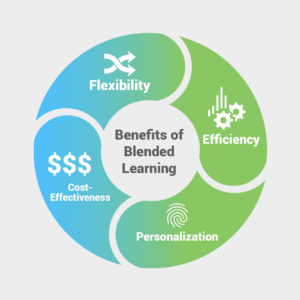What is Blended Learning?
As continuing education becomes a mainstay of organizations seeking to enhance their employees’ value and increase retention, blended learning is the logical way to retrain, cross-train, and upskill existing staff.
This form of assisted learning moves the model away from an all classroom or all independent-based environment putting the student in charge of deciding how much support they need at any given point.
Hybrid learning allows students to self-direct a portion of their educational experience by replacing sections of classroom-based instruction time with an online curriculum (that often includes on-demand access to a qualified instructor). This approach allows each student to learn at their own pace, resulting in improved absorption of educational materials and reduced stress levels. A blended learning model can also minimize the amount of micromanagement involved in onboarding and training from an HR perspective.
What qualifies as blended learning?
Blended learning is flexible, meaning there can be multiple working models that are appropriate for different situations. Typically, any model combining a traditional classroom or one-on-one instruction experience with segments of self-directed, online education can be classified as hybrid learning.
The split can be 50-50 or tipped in favor of either classroom-time or online modules. Most blended learning models are highly interactive, utilizing audio and video in addition to readable text and online quizzes. Students can access the support they need when they need it, and pace their experience to absorb as much knowledge as possible.
What are the advantages of blended learning?
Flexibility
Reducing the amount of physical time in a classroom and allowing employees the ability to choose when and where they learn can enable students to study in a way that works best for them. The flexibility of time and place can help them learn when and where most appropriate; reducing unwanted disturbances or distractions.
employees the ability to choose when and where they learn can enable students to study in a way that works best for them. The flexibility of time and place can help them learn when and where most appropriate; reducing unwanted disturbances or distractions.
Efficiency
In a classroom, attention can wander and missing a few minutes of a lecture can often lead to complete inability to regain the thread of the lesson. With a blended approach, students working through lessons online can pause, backup, and even restart if an interruption of focus occurs. This improves the efficiency of learning since time isn’t wasted trying to backtrack and find out where they lost the thread of the lecture or class.
Personalization
Lesson plans can come in a variety of presentations – including text, images, audio, and video options. This variety allows for accessible accommodation of any learning preference keeping auditory and visual learners abreast of the same material with ease.
Cost-effectiveness
One of the most significant advantages of hybrid learning is the lower cost associated with getting a class from course starting point to its completion. Assisted learning options are less costly to your organization, and can deliver exceptional results.
Do students like hybrid learning?
Students presented with blended learning options are more motivated to succeed and report higher levels of satisfaction with their own progress. Being able to work at an individual pace, get help when needed, and track their development were all key attractions for hybrid learning graduates.
Many employees find assisted learning containing a substantial percentage of online classes to be more accessible than employer reimbursed courses. Traditional learning requiring an upfront financial investment followed by days spent at a learning facility to complete the expected hours of education (and subsequent testing) can often be a challenge for those with already tight work/home schedules.
Top benefit of blended learning in the workplace
Hybrid learning used for employee training can boost morale, keep employees invested, and reduce turnover. When it comes to what is important to employees, career development and learning are almost twice as important as compensation, benefits, and work environment.

The average employee has only one percent (24 minutes per week) of their work time available to devote to training. Blended learning can provide workers with the drive to advance their career through education with the chance to achieve their goals, helping them learn when they are available.
Adopting a blended learning strategy
If you’re ready to implement a hybrid learning approach in your business, classroom, or program, you’ll need to embrace cloud technology and be prepared to integrate assisted learning into your existing framework. Seek tools and systems that will foster interaction and engagement with students.
Be hands-on with curriculum adaptation, and think about future skilling your students or workforce. By leveraging a blended learning environment, you can build a solid employee base that will be capable of supporting your organization more fully, or a graduating class of students ready to take on the world with comprehensive knowledge and skills.
By offering assisted learning, you make it clear to your students and/or employees that you not only see their potential but are committed to nurturing it. By providing the opportunity for them to learn and grow, you foster self-confidence, leading to better learner outcomes and strong, long-term relationships.


